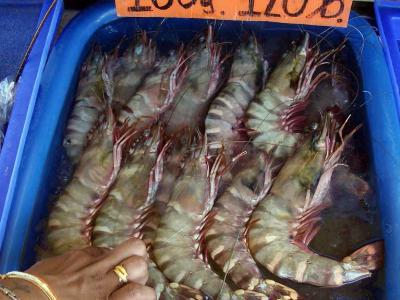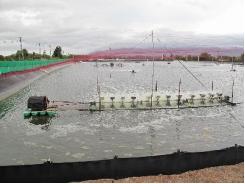Black tiger shrimp becoming the new lobster

As black tiger shrimp becomes harder and harder to find, especially at sensible prices, there is talk of it becoming a high-end, niche product, say industry players.
“I’m sure the large part of the market, even those who are currently using black tigers, will shift to white [shrimp], even traditional markets like Japan or Canada, as white gain more availability, and better prices,” Sree Atluri, an executive with US importer Devi Seafoods,.
“We could compare black tiger to a lobster – a small, niche market for a higher priced item.”
Traditional producers of black tiger shrimp – Vietnam, Indonesia, Thailand and particularly India – have been converting their ponds to white (vannamei) shrimp for years, due to the notable ease and higher returns presented by the species.
But seemingly in the first quarter of 2013 the supply in shortage is really hitting, with prices rocketing around 25% in three months (see the graph below).
Despite the escalating price gap between black tiger and white shrimp, there remains a small segment of customers willing to pay for what some see as the higher quality product.
“There is a demand for sure, there are a lot of people who want to continue on tigers, they think it is a better shrimp than a white, and there are people asking for it,” said Atluri.
“There are a few people still buying, even though the supply is low and the price is high. Demand is strong from a small sector of customers for sure – meeting it is becoming the challenge.”
He noted that demand is from foodservice rather than retail, which has joined the growing numbers shifting to white shrimp instead.
“It’s increasingly becoming a high end product. The pricing variation has been widening, now there’s a good gap between tigers and whites and we have been getting an increasing premium on tigers,” he said.
As it stands the prices for black tiger are at $1 – $1.20 higher than equivalent sizes for white shrimp, said Atluri.
“Vietnam keeps plugging along with black tiger production, it has dropped but they continue with significant quantities. It would seem the premium for black tiger makes continued production in Vietnam feasible”
“[The price gap] is across all sizes, I’m sure while the demand on some sizes will get slower, the demand on larger sizes will go up much higher, because whites are not produced in larger sizes like 6-8, it’s impossible for a farmed shrimp white to grow to that size.”
As the supply of white shrimps of sizes that are in demand improves, the price gap is going to widen rapidly in the next few weeks, predicts Atluri.
Devi is not the only US firm to note the scarcity of black tiger, with a recent note sent out by Chuck Anderson of Pierfish noting the shortage caused by the move of most producers to white.
Move to more profitable farming
Several other sources confirmed that black tiger appears to be becoming a niche product.
“The market for black tiger is becoming narrower and almost niche,” said Jim Gulkin, managing director of Siam Canadian Group.
“Vietnam keeps plugging along with black tiger production, it has dropped but they continue with significant quantities. It would seem the premium for black tiger makes continued production in Vietnam feasible,” he said.
In many of the shrimp-producing countries ponds have been converted to white shrimp, hence the supply shortage.
“Indonesian black tiger is now almost 100% traditional farming, with no more intensive as far as I know of,” one source, a top sales executive with an Asian exporter, told Undercurrent.
This traditional method is used in parts of India, such as the Calcutta area, and parts of Bangladesh, to raise black tiger, explained Atluri.
In these regions farmers allow ponds to be filled by waters from estuaries, and leave the shrimp to grow at very low stocking densities, eating natural feed. This method allows them to grow to larger sizes than white shrimp, but it produces so few that the numbers are now almost negligible, he said.
“We expect tigers to be short and in strong demand with higher prices, at least for this year. Basically it appears that there is not enough tiger production to meet US and global demand”
The widespread conversion to white shrimp, which has been especially evident in India, has been down to the simple fact that vannamei is much easier to grow and yields better bottom lines (the current disease problems notwithstanding).
“Black tiger production in India is dropping because vannamei is cheaper to raise, and the yields from vannamei farming can be three to five times higher,” said Gulkin.
“Also, vannamei grow out in a much more uniform size ratio. The bottom line is farmers can have much more production from a vannamei farm than a black tiger farm and therefore make much more money. This is why black tiger production almost disappeared from Thailand, and dramatically dropped in Indonesia.”
The explosion of white shrimp production would not have been possible without the substantial black tiger farming and packing infrastructure which already existed in India, a US-based importer toldUndercurrent.
“Indian farmers have reached the same conclusion that farmers in other Asian white shrimp farming areas reached 13 years ago: simply put, white shrimp are easier to raise,” he said.
He added there have been reports Japanese tiger buyers have shifted to white shrimp on the back of high prices, though he questioned why this had not freed up supply for the US, finding, as Atluri has, that supply is hard to come by.
“Overall, we expect tigers to be short and in strong demand with higher prices, at least for this year,” he said. “Basically it appears that there is not enough tiger production to meet US and global demand.”
Related news
Tools

Phối trộn thức ăn chăn nuôi

Pha dung dịch thủy canh

Định mức cho tôm ăn

Phối trộn phân bón NPK

Xác định tỷ lệ tôm sống

Chuyển đổi đơn vị phân bón

Xác định công suất sục khí

Chuyển đổi đơn vị tôm

Tính diện tích nhà kính

Tính thể tích ao




 Nursery phase in shrimp farming, benefits beyond EMS
Nursery phase in shrimp farming, benefits beyond EMS  Aeration with pond capacity, Importance of Aeration and…
Aeration with pond capacity, Importance of Aeration and…